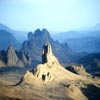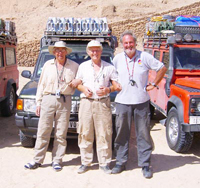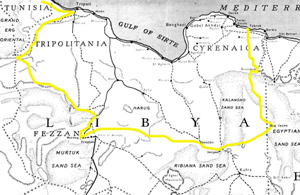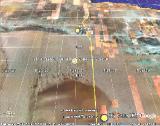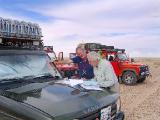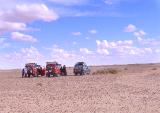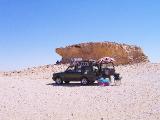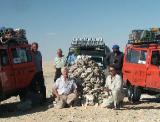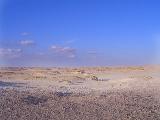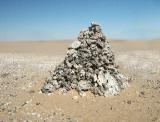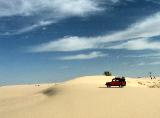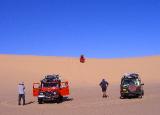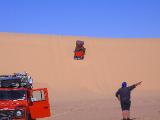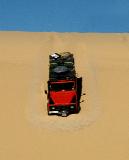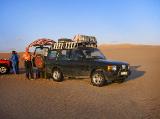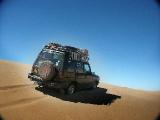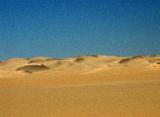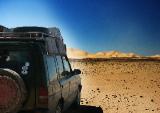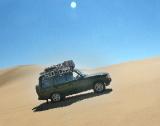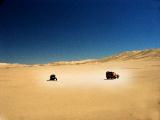A celebratory re-run of
the Long Range Desert Group's expedition
to Murzuq, Libya, has now been completed.
The original expedition was accomplished by the newly formed
LRDG in 1941.
The dune-encircled oasis of Murzuq was,
in 1941, a heavily armed supply base for Mussolini's forces.
Situated in the middle of Libyan Fezzan, it was considered a
safe haven, protected from attack by it’s natural desert
defences. Targeting this remote site, two LRDG
patrols set off on a secret sortie across the Libyan Sand Sea
in late 1940, complete with all supplies for their raid. They
were commanded by Major Pat Clayton, a renowned mapper from
Egypt, and Captain Michael Crichton-Stuart, Scots Guards.
They crossed over 1,200 miles of open
desert, took Murzuq by complete surprise, destroyed the ammunition
dump, blew up the bomb depot and demobilised the aeroplanes.
The raid was an outstanding success. It was
widely hailed for its audacity and daring, and has captured
the imagination of desert travellers ever since.
In October 2006 a group of desert travellers embarked on a celebratory
re-run in three Land Rovers to follow the steps of this ground-breaking
LRDG raid . The group included…
Kit Constable-Maxwell,
FRGS, group
coordinator, ex Scots Guards, traveller, photographer. A veteran
of extensive desert travels in North Africa, Saudi Arabia, Afghanistan,
India, Nepal, Tibet, China.
Dr Raymond Bird, FRGS,
navigator, ex RAF, widely experienced in deserts hot and cold,
including Pamirs, Afghan, Sinkiang, Oman, Egypt, Libya, USA,
Chile, Namibia and most other parts of the world.
Richard Noble, OBE,
an experienced desert traveller and well known for his unparalleled
achievement in gaining and holding the world Land Speed Record
in his cars,'Thrust 2' and'Thrust SSC'.
Our group also included Nick
Robinson, Crispin Clay and Simon
Montford who were each an essential part of the team,
together with Mamadu, our Touareg guide
and Hassan, our resident 'gendarme'.
| |
|
Murzuq 06 Raid.
Via Tobruk to Big Cairn, then following LRDG's route
westwards to Murzuq.
Total track shown, approx 2,300 miles |
The terrain varied from steep dunes to rock-strewn plains.
We drove down dune corridors in the Kalansho Sand Sea, crossing
the range at dune gaps to maintain heading. Our
longest leg between supplies was almost 1,000 km. We carried
all fuel, rations and water supplies with us.
We passed several wartime sites, one of
which was Rigel Ridge which was so lucidly described by Andrew
Constable Maxwell, MC, Scots Guards. His company suffered heavy
losses while under fire. It was surrounded by Rommel's tanks
and then captured. Although wounded in this action, he escaped
across the desert and returned to his parent unit. To read his
report, Click
here
Here are the interim reports of the trip as posted
en-route on the Kitmax Blogsite
Libyan Expedition - honouring the
Long Range Desert Group.
|
Wednesday 4th October 2006 -
rendezvous an Aix en Provence
We are off to Libya at last. Raymond Bird and Kit Constable
Maxwell are in a well-loaded Land Rover Discovery. We
had a 10 hour drive to Aix en Provence where we met
up with two Land Rover Defenders. Richard Noble and
Nick Robinson are in one. Crispin Clay and Simon Montford
are in the other. Richard's brother, Andrew, came to
bid us farewell and brought us a case of wine for the
journey.
|
|
|
|
Satellite
positioning |
Raymond navigating |
Mediterranean
campsite |
|
Thursday 5th October 2006 - sea crossing
We arrived at Marseille and board ship for the 22 hour
crossing to Tunis. Comfortable berths and good ship.
We assembled at tea time for a drivers briefing. Kit
explained the intricacies of dune driving, Raymond explained
the route and the itinerary, and Nick briefed us on
first aid.
Friday 6th October 2006
- Tunis customs house
Arrived in Tunis and docked at 11 o'clock to be greeted
by shouts, waves, officialdom, beaurocracy, gendarmes
and douanes all giving conflicting instructions. Self-appointed
fixers argued amongst themselves and gesticulated wildly.
Welcome to North Africa!
Richard was directed into the 'residents' channel and
had his walkie-talkie impounded. Very irritating and
time consuming, but not serious as we got them back
later. We left the dock 2 hours late and drove the length
of Tunisia. In the small southern villages Chilli beans
were hung out to dry - a colourful red adornment to
the simple white buildings.
We arrived at Matmata which has been home to Troglodite
communities for centuries. We booked into the Troglodite
Hotel El Barbar and were shown to a cave - albeit one
with white marble floors and four poster beds.
|
| |
|
|
| Tobruq
road |
Route
planning |
El Adem campsite |
|
Saturday 7th October 2006 Arrive
in Libya – First desert camp
We cleared Tunisia customs in record time (about 2 hours)
and Richard recovered his walkie-talkie set. We entered
no-man's-land and were greeted by a tall welcoming Touareg
with a broad smile, clutching our Visas.
We fitted our new Libyan number plates and set off for
Sabratha. We reached the historic Roman ruins and set
up camp by the car park.
Many camping skills were learnt here, new equipment
unleashed from factory wrappings, and everything was
going well when we were hit by a sudden rain squall.
We all got wet and it was an honourable christening.
Sunday 8th October 2006
Sabratha ruins revealed unrivalled craftsmanship and
we walked down paved streets 2,000 years old, examining
temples, forums, squares and a splendid theatre. The
site borders the sea and the waves lapped gently.
We drove on to Tripoli, passing the pretty harbour and
continued to Leptis Magna. The size and scale of this
important Roman site is amazing, as is the quality of
stone and marble carved into decorative features, capitals
and plinths. More on this later. We camped for the night
under sun-baked palms.
Monday 9th October 2006
We drive all day and camped at Ben Jawad on the Mediterranean
sea-shore. Very nice camp site, but windy and too rough
to swim.
Tuesday 10th October 2006
Long driving day. We woke at 6 o'clock and left camp
at 8 o'clock. We are now in a flat barren desert inhabited
by the occasional family of camels. We reached El Adem
finally (I was last here in 1959... and it hasn't change
as much as I have!) and camped in a welcoming desert
wadi.
|
|
|
|
|
Tobruq harbour |
El
Adem supply point |
Eroded
rocks |
|
Wednesday 11th Oct 2006
Drove to Tobruk. A nice harbour, sparkling
in the morning sun. We visited the German War memorial,
a very fine fort built on a high bluff. Then we left
for the long drive to Jagbub where we topped up all
fuel and water containers. We were now heavily laden,
I was carrying 300 litres of fuel and a hundred litres
of water.
We turned off into the desert and found an old abandoned
piste. We had to climb a sandy ridge to gain the plateau,
and we all got stuck at different places. Sand ladders
were used for the first time and we were soon free.
At dusk we descended into a picturesque valley, located
by our Touareg guide Mamdu, with soft sandy patches
and eroded rocky outcrops for windbreak. Perfect for
camping and here we spent the night.
|
|
|
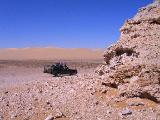 |
|
|
|
|
Thursday 12th October 2006
We viewed a memorable desert storm with a bright red
halo rising over the dunes. After breakfasting on pâté,
jam and crispbread, we drive out of our camping valley
and rattle off across the stony plateau. Soon the terrain
turns increasingly sandy and we started negotiating
dunes and soft sand. Now we are deep into the boundless
reaches of the Kalansho Sand Sea - this is real desert,
a land beyond time, an unbounded void reaching from
horizon to horizon. We dropped our tyre pressures to
increase flotation.
We passed some picturesque rock formations, sculpturally
eroded by sun, wind and time. We reached Bir Salama,
an abandoned pumping station and continued south eastwards.
The temperature is now 95° Farenheit. We climbed
many long ridges and descended some alarmingly steep
dunes. In the afternoon we hit a large area of soft
sand and frequently had all three cars stuck at once.
We used straps, towropes and sand ladders, waffle boards
and old fashioned push-and-shove. By evening we were
all much fatigued and ready to stop. We found a wonderful
site in the dunes and built a fire.At nightfall everyone
sang 'Happy birthday to Kit' and I was presented with
one of the group's last Mars bars!
|
| |
|
|
| Filling
cans |
Bread supplies
at Jagabub |
Into desert
landscape |
|
Friday 13th Oct 2006
-
We left camp early and drove into progressively worsening
sand. We made some amazing dune descents and crossed
some beautiful desert landscape. By mid morning we were
driving down a dune corridor, flanked by great dunes
on either side. Many times we broke through the crust
and sank up to the wheel arches in powder-soft sand.
By noon we left the reaches of the sand sea and set
off over a flat plain and cruised across the unmarked
border into Egypt. This led us to our primary destination
'Big Cairn'.
We arrived at lunch time and basked in the memory of
this historic place. We all felt chuffed, three thousand
miles from UK. This is the place where the LRDG left
friendly territory and entered enemy held terrain. We
lined up our Land Rovers for a photograph and later
we left to drive west, following the LRDG's route. We
camped in a great flat sandy plain just near the crash
site of ‘Lady be Good’ a war time US liberator
aircraft.

Big Cairn revisited |
|
|
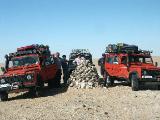 |
|
|
|
|
|
Saturday
14th October 2006
We were driving west across the plain following the route
of the LRDG after they left Big Cairn. The
cairn was used as a survey point built by Major Clayton
in 1934. In this otherwise featureless desert it was a
good location for LRDG’s fuel dump on the 1941 Murzuq
raid. It must be one of the most historical stone cairns
in the Sahara. Many LRDG and SAS units rendezvous-ed here,
and it was a powerful experience to tread the ground of
history. We saluted brother soldiers and played the wartime
favourite 'Lily Marlene' on the radio as we left.
|
The plain ended and we encountered the southern reaches
of the Kalansho Sand Sea. In the jumble of cross-directional
dunes interspersed with stony outcrops it was a difficult
drive. Our speed varied between 50 mph and 15mph depending
on terrain. We were able to drive along the smooth crest
of long whale-backed dunes and made good progress until
the next slow, stony area.
We crossed the Kufhra road in late afternoon, the first
sign of inhabitation for 1,000 km. Clumps of tamarisk
trees announced the Bir Zeigen area where we camped.
|
| |
|
|
|
| Rebuilding
Big Cairn |
Big Cairn
at last |
Big Cairn |
Stony sand
crossing |
|
Team Profiles
We have integrated well as a strong and competent group,
to celebrate the LRDG’s historic Murzuq raid.
The team members are:
Richard Noble – a master planner who
will be seen with notebook and calculator logging food,
fuel and water stock, checking supplies and plotting
GPS fixes. Richard finds the Landrover pace quite slow
compared with his other car……….Well,
as a 633 mph Land speed record holder he would, wouldn’t
he? He is also the team’s self-appointed dishwasher
which says much for his style...
Nick Robinson –
a rally driver of good, excellent and amazing classic
cars. A quick learner, skilled driver and a fund of
information and facts. In charge of medical supplies
and first aid skills for the group.
Raymond Bird - reliable,
amiable, and a great navigator. Fuelled by industrial
strength tea and accomplished map reading skills he
is the group’s senior member and it’s strongest
asset.
Crispin Clay – confident driver,
and warm personality, backed by good mechanical skills,
entrusted with sourcing all self-recovery equipment,
vehicle maintenance and equipment storage.
Simon Montford –
lively, active and much motivated. He is learning Arabic
from our Touareg guide, playing Arabic poker with our
gendarme. He may be seen bronzing himself on top of
a moving Land Rover, or conducting film interviews en-route.
Kit Constable Maxwell
– solid research and planning skills derived from
numerous desert travels, many of them alone. Lifelong
Land Rover user, ex Scots Guards and French Para’s.
Historical adviser to the group on LRDG skills, deployment
and achievements.
|
|
|
|
Mined wartime
cars |
Desert terrain |
Lots of sand |
|
Sunday 15th October 2006
We practiced dune-driving skills before leaving camp
and drove to Tsaibo, a small outpost town. We replenished
fuel and water. This is our first supply since leaving
Jagbub - five days and a thousand kilometres away. Difficult
sandy drive out of the town and off across the plain.
We reached the dune corridor, in the Ribiana
Sand Sea . We found a picturesque dune site and camped
for the night. Silence, space and eternity.
|
|
|
|
Land Rover
descent |
Weird erosion |
Desert horizons |
|
Monday 16th October 2006
Drove down our dune corridor and came to the great dry
lake. The shore was covered with mussel, oyster and
clam shells - an extraordinary feature in this waterless
desert.
We found, after some searching, the well preserved wreck
of a 1930’s bi-plane which had crashed here. We
took photos and examined every piece with interest.
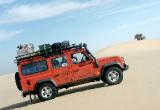
Campsite at Bir Zeigen |
|
|
|
|
|
|
|
Long and difficult drive on blackened
sand to the volcano at Waw Namus. This is an amazing
site, lost in a vast tract of soft black sand is the
volcanic crater, about 2km wide . We stopped and looked
down at the great central core surrounded by three shimmering
lakes bordered with lush green vegetation.
The temperature has soared to 104.6° F ( over 40
°C) and both cars and passengers are feeling the
strain. We camped later by sandy dunes in the cool of
the evening.
|
Routine
I sleep with my tent door open and awake before
dawn. I then pack up the tent, go down to the Land Rover,
fill up the kettle and fire up the burner.
Raymond joins me and we take our place on our desert
chairs – each next to a storage box which doubles
as a dining table.
Richard is next to get up, always chirpy, followed by
Chris who appears out of his swagman’s sleeping
tube and Simon from his 5-star camp bed. Nick appears
at the first hint of breakfast. There is a rustle from
the floor and Mamdu, our memorable Touareg guide emerges
from under a ground sheet.
We breakfast on coffee and strong tea with pâté
and crispbread for Raymond and jam for me.
After breakfast, Raymond holds a briefing on the day’s
itinerary and we discuss special challenges, recommended
tyre pressures and rendezvous points.
We then carry out maintenance checks, pack up and move
off around 08.30 hours. The Discovery with navigator
and Touareg guide will lead, with the two Defenders
second and third in order.
At 11 o’clock we stop for elevenses and at 1 o’clock
we stop for a two- hour break.
I take out two jerry-cans and stand them in the sand,
then I install the ‘Kitmax twin-top tuckbox’,
open both lids and remove - mugs, tea, sugar, kettle,
crockery, cutlery and soup, and all accessories for
lunch.
Then I assemble the large door-mounted parasol and we
set out our chairs and storage boxes…… and
prepare a lunch of soup, mackerel fillets, mayonnaise
and local bread where available.
Between 5pm and 6pm we find a camp site. This may be
on a dune or under a group of palm trees or tucked in
a maze of tamarisk mounds. Sometimes our camp is just
a speck on a great boundless plain.
We set up our tents and unpack our cars. We light a
fire and prepare for dinner. Out comes the 'Kitmax twin-top
tuckbox' again and tonight we will have dehydrated soya
mince. I add generous portions of red peppers, carrots,
potatoes and onions, all bought in local stalls en-
route.
|
|
|
|
Site meeting |
Elevenses
stop |
Mushroom
rocks |
|
Tuesday 17th October 2006
We awoke early and returned to the volcano for dawn
pictures. Very beautiful. Back to camp site at 09.00
for vehicle maintenance. We left camp at 14.00 hrs for
a long uncomfortable drive west. Turned off the main
piste eventually and camped in a wide plain dotted with
patches of soft sand, bordered with white lime stone.
Highlight of the day was to discover the wreck of a
Chevrolet truck of the sort used by the LRDG. Who knows
now, so long ago, what story it could tell...
DESERT BRIGANDS
We were now three weeks into our desert dash and looking
much like a troop of brigands. Richard has a big brindle
beard, Crispin and Simon have one too. Nick looks like
the chief brigand in his Touareg head-dress, and my
hair has not seen a brush from day one.
Wednesday 18th October 2006
We cross a huge sand plain, part of the Murzuq Sand
Sea. The Land Rovers could be seen shimmering in their
own mirage. With no clear boundary the horizon was lost
in a distance haze where land meets the sky. Arrived
at Tmissa, re-fuelled and turned West for the final
run to Murzuq.
We camped in another picture book dune valley and we
all sang Lili Marlene after a candle-lit dinner.
|
|
|
|
Great sandy
landscapes |
Disco first
down |
Lunch break |
|
Thursday 19th October 2006
Murzuq Retaken
Suddenly we reached Murzuq……..
We drove through the town, an old Saharan trading post
and an important slave route in the 17th Century. We
made a triumphant entry in our imposing desert-dressed
Land Rovers, singing 'Rule Britannia' and 'Land of Hope
and Glory'.
The locals could only gasp in amazement. They have seen
so many invaders in their history, from the Romans to
the Italians, the Germans to the British. We rounded
a corner and there stood the old Sultan's Fort, just as it did
when the LRDG arrived all those years ago. It was a
grand, imposing desert building, complete with guard
room, inner courtyard and crenulated ramparts. It stood
on a slight rise overlooking the town.
This was our journey’s end and our rendezvous point. The modern Italian military fort nearby was the
LRDG’s primary target, and it fell to Captain Michael
Crichton-Stuart and the Guards Patrol to subdue it, while Major Pat Clayton raced off to the adjacent
air field and disabled the aeroplanes, bombs, arms and
fuel depot. The defenders were far from ready but rallied
with commendable speed. The 15 trucks of the Guards
patrol had to employ skilled fieldcraft to gain an offensive
position without compromising their safety.
I had planned this day for 5 years... and now it was
here. We drove into the spacious courtyard of the old fort with many
emotions; the joy of achieving our long sought goal,
and reserve that our expedition was nearing its conclusion.
We lined up the three Land Rovers in front of the main
entrance, posed for photographs, shook hands and celebrated
our great journey. We saluted absent friends of the
LRDG, waved our Union Jack flags and moved off to the
old airfield where we found a bullet-scarred hangar
inhabited by wild dogs.
What a great achievement that LRDG raid had been, over
a thousand miles behind enemy lines, 30 trucks navigated
over the most inhospitable terrain on the planet. Now,
65 years later, we had re-run the journey. We used the
time-proved Land Rovers to meet the challenge together
with satellite navigation and imagery to navigate by.
|
|
|
|
|
Descending
big dune |
Steep descent |
Safely down |
|
We still had a very long way to travel
and the journey included many tough dune crossings.
The crest of a dune is a challenging obstacle which
demands sympathetic treatment; it comes to a sharp peak
on the windward side before dropping away suddenly and
sharply on the soft leeward side. We try to perch on
the crest, slightly nose-down, for long enough to plan
an orderly descent. But this skill is hard won, and
we frequently stall, half way up the crest, deeply embedded
in the sand, unable to proceed or reverse. Once on the
crest, we may become bellied down on an unforgiving
myriad of sand particles, with no wheel-contact front
or back.
|
|
|
|
|
Teatime break
|
Land Rovers
on skyline |
Reconnoitring
descent |
|
Friday 20 October 2006
Mandara Lakes
After the excitement of yesterday’s arrival at
Murzuq our camp site at Camp Africa nearby was both
welcome and timely and we spent the rest of the day
washing our clothes, refitting and repacking for the
journey ahead.
We left camp and drove up to some mountainous dunes
using every ounce of power and traction available.
This is a steep, soft and difficult drive and after
a few sandy extractions we were high on the dune plateau.
We stopped on a ridge and far below was a picture book
oasis, Lake Mandara. The water was a deep blue, fringed
with rushes and palm trees and completely surrounded
on all sides by huge sand dunes. This is one of several
lakes in this area isolated by time and accessibility.
We then visited the 2000-year-old Garamantes town at
Germa and camped in the dunes later.
|
 Dune descent
Dune descent |
|
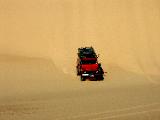
Sandy bow wave |
|
Saturday 21st October 2006
We fuelled up the cars for a long desert crossing, over
800 km of rock and sand skirting round the edge of the
Awbari Sand Sea. We allowed 25% extra fuel and 5 days
supply of water.
We made good time on the road, and it was very hot and
I used the air conditioning in the last town.
We entered the sand sea at 4pm and encountered several
herds of camel with their drivers, returning to camp
in the setting sun against the background of wind sculpted
dunes. A scene unchanged for centuries.
Memories are made of this………..
A sudden deep hole caused a sickening crunch as the
Discovery’s well-laden suspension hit the bump-stop
hard, the jolt also broke the fixing on my roof rack.
The suspension survived. Crispin and I repaired the fixing later with bolts,
nuts, clamps, ingenuity and imagination. We followed
a beautiful sand track to an outcrop of small palms
and scattered bushes and dust.
Camped in a shallow sand valley bordering the Sand Sea.
|
|
|
|
Morning break
|
Afternoon
break |
Evening parley |
|
Monday 23rd October 2006
We reached Derj in the late afternoon, well on schedule.
We continued to Ghadames where we visited the old town.
15,000 people lived in this rabbit-warren edifice which
was served by a good well and sported many gardens and
date palms - which supplied a living for the occupants.
We dropped off Mamdu, our excellent Touareg guide who
had accompanied us for the whole route. His knowledge
of sand, dunes and desert terrain was unfathomable.
Later we camped on soft dunes. Tomorrow
we drive north and in a few days will reach Tunisia.
A few days later we will take the Mediterranean crossing
to Europe.
This has been a tremendously successful expedition and
many thanks go to the many suppliers, advisers, and
well-wishers who supported us on our trip.
|
| |
|
|
|
|
|
Driving wadi
piste |
Crossing
the border |
Prospecting
route on foot |
|
| |
| |
|
|
|
|
|
 Boundless dune landscape
Boundless dune landscape |
|
|
|
|
|
|
| |
|
|
|
| |
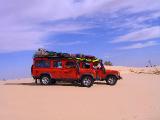 Campsite in the sands
Campsite in the sands |
|
|
|
|
|
More pictures, un-sorted, click here:
http://www.kitmax.com/kit12_travels_14_murzuq_jalbum/
ŠKit Constable Maxwell
|
|


